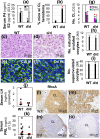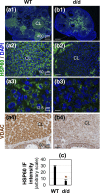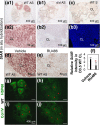Deletion of RhoA in Progesterone Receptor-Expressing Cells Leads to Luteal Insufficiency and Infertility in Female Mice
- PMID: 28498971
- PMCID: PMC5505209
- DOI: 10.1210/en.2016-1796
Deletion of RhoA in Progesterone Receptor-Expressing Cells Leads to Luteal Insufficiency and Infertility in Female Mice
Abstract
Ras homolog gene family, member A (RhoA) is widely expressed throughout the female reproductive system. To assess its role in progesterone receptor-expressing cells, we generated RhoA conditional knockout mice RhoAd/d (RhoAf/f-Pgr-Cre+/-). RhoAd/d female mice had comparable mating activity, serum luteinizing hormone, prolactin, and estradiol levels and ovulation with control but were infertile with progesterone insufficiency, indicating impaired steroidogenesis in RhoAd/d corpus luteum (CL). RhoA was highly expressed in wild-type luteal cells and conditionally deleted in RhoAd/d CL. Gestation day 3.5 (D3.5) RhoAd/d ovaries had reduced numbers of CL, less defined corpus luteal cord formation, and disorganized CL collagen IV staining. RhoAd/d CL had lipid droplet and free cholesterol accumulation, indicating the availability of cholesterol for steroidogenesis, but disorganized β-actin and vimentin staining, indicating disrupted cytoskeleton integrity. Cytoskeleton is important for cytoplasmic cholesterol movement to mitochondria and for regulating mitochondria. Dramatically reduced expression of mitochondrial markers heat shock protein 60 (HSP60), voltage-dependent anion channel, and StAR was detected in RhoAd/d CL. StAR carries out the rate-limiting step of steroidogenesis. StAR messenger RNA expression was reduced in RU486-treated D3.5 wild-type CL and tended to be induced in progesterone-treated D3.5 RhoAd/d CL, with parallel changes of HSP60 expression. These data demonstrated the in vivo function of RhoA in CL luteal cell cytoskeleton integrity, cholesterol transport, StAR expression, and progesterone synthesis, and a positive feedback on StAR expression in CL by progesterone signaling. These findings provide insights into mechanisms of progesterone insufficiency.
Figures





Similar articles
-
Association of luteal cell degeneration and progesterone deficiency with lysosomal storage disorder mucolipidosis type IV in Mcoln1-/- mouse model†.Biol Reprod. 2019 Oct 25;101(4):782-790. doi: 10.1093/biolre/ioz126. Biol Reprod. 2019. PMID: 31317194 Free PMC article.
-
Regulation of cellular communication network factor 1 by Ras homolog family member A in bovine steroidogenic luteal cells.J Anim Sci. 2022 Jul 1;100(7):skac124. doi: 10.1093/jas/skac124. J Anim Sci. 2022. PMID: 35772754 Free PMC article.
-
Misregulated progesterone secretion and impaired pregnancy in Cyp11a1 transgenic mice.Biol Reprod. 2013 Oct 17;89(4):91. doi: 10.1095/biolreprod.113.110833. Print 2013 Oct. Biol Reprod. 2013. PMID: 23966322
-
Roles of antioxidant enzymes in corpus luteum rescue from reactive oxygen species-induced oxidative stress.Reprod Biomed Online. 2012 Dec;25(6):551-60. doi: 10.1016/j.rbmo.2012.08.004. Epub 2012 Sep 12. Reprod Biomed Online. 2012. PMID: 23063822 Review.
-
Localization of steroidogenesis and steroid receptors in human corpus luteum. Classification of human corpus luteum (CL) into estrogen-producing degenerating CL, and nonsteroid-producing degenerating CL.Semin Reprod Endocrinol. 1997;15(4):345-51. doi: 10.1055/s-2008-1068372. Semin Reprod Endocrinol. 1997. PMID: 9580943 Review.
Cited by
-
Visualization of preimplantation uterine fluid absorption in mice using Alexa Fluor™ 488 Hydrazide†.Biol Reprod. 2023 Feb 13;108(2):204-217. doi: 10.1093/biolre/ioac198. Biol Reprod. 2023. PMID: 36308434 Free PMC article.
-
Updates on molecular and environmental determinants of luteal progesterone production.Mol Cell Endocrinol. 2020 Sep 15;515:110930. doi: 10.1016/j.mce.2020.110930. Epub 2020 Jun 28. Mol Cell Endocrinol. 2020. PMID: 32610113 Free PMC article. Review.
-
Seipin deficiency leads to defective parturition in mice.Biol Reprod. 2017 Sep 1;97(3):378-386. doi: 10.1093/biolre/iox088. Biol Reprod. 2017. PMID: 29088395 Free PMC article.
-
Effects of P4 Antagonist RU486 on VEGF and Its Receptors' Signaling during the In Vivo Transition from the Preovulatory to Periovulatory Phase of Ovarian Follicles.Int J Mol Sci. 2021 Dec 16;22(24):13520. doi: 10.3390/ijms222413520. Int J Mol Sci. 2021. PMID: 34948315 Free PMC article.
-
Mechanosensitive Steroid Hormone Signaling and Cell Fate.Endocrinology. 2022 Aug 1;163(8):bqac085. doi: 10.1210/endocr/bqac085. Endocrinology. 2022. PMID: 35678467 Free PMC article.
References
-
- Shimokawa H, Sunamura S, Satoh K. RhoA/Rho-kinase in the cardiovascular system. Circ Res. 2016;118(2):352–366. - PubMed
-
- Rhee SH, Zhang P, Hunter K, Mama ST, Caraballo R, Holzberg AS, Seftel RH, Seftel AD, Echols KT, DiSanto ME. Pelvic organ prolapse is associated with alteration of sphingosine-1-phosphate/Rho-kinase signalling pathway in human vaginal wall. J Obstet Gynaecol. 2015;35(7):726–732. - PubMed
Publication types
MeSH terms
Substances
Grants and funding
LinkOut - more resources
Full Text Sources
Other Literature Sources
Medical
Molecular Biology Databases
Research Materials
Miscellaneous

